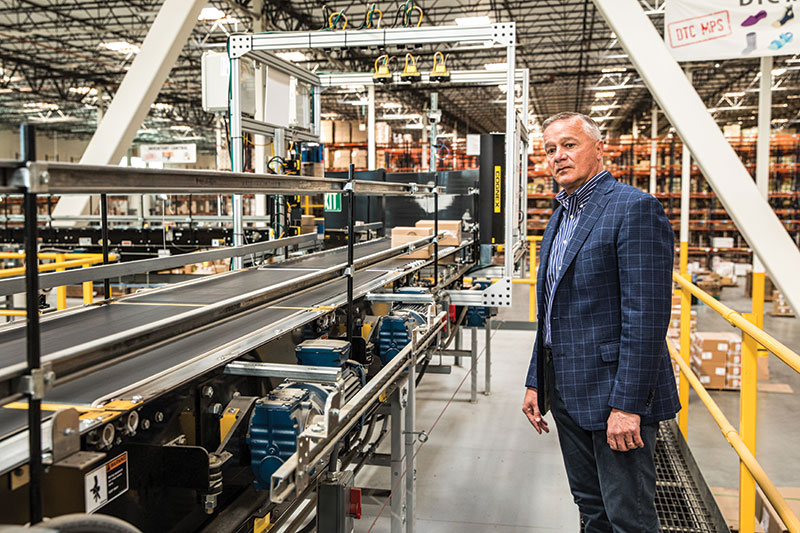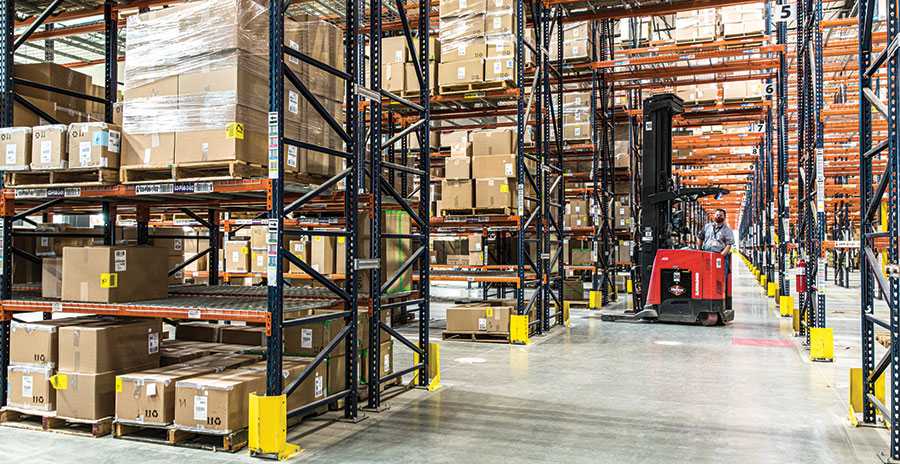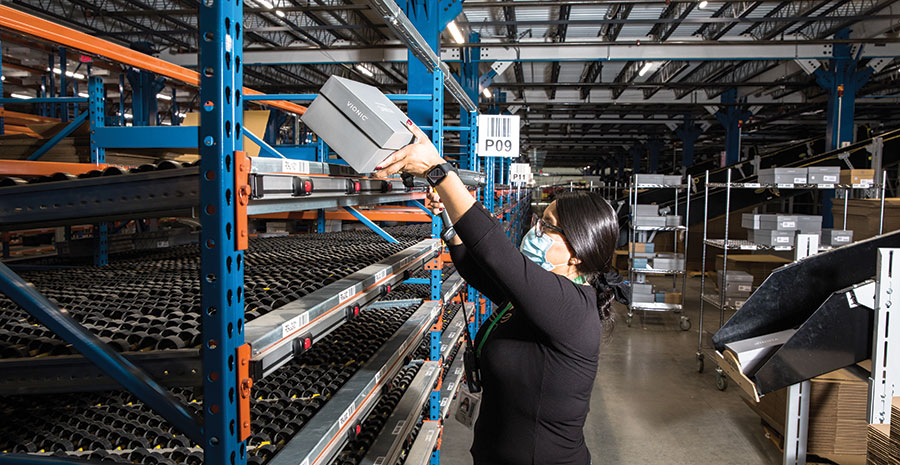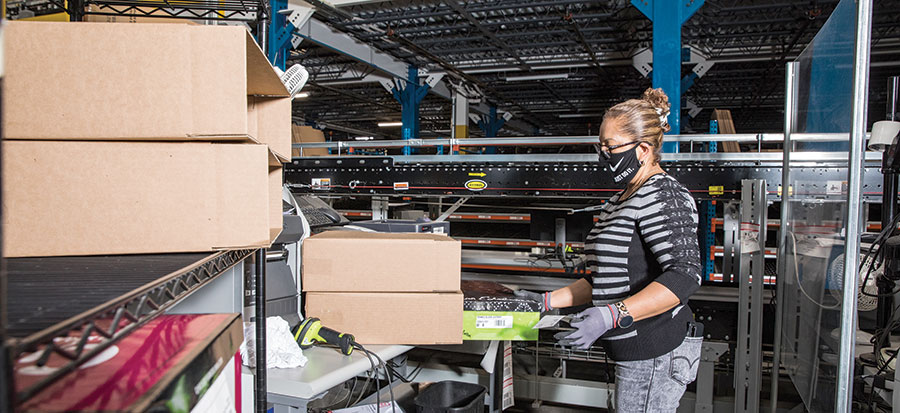Caleres steps into a new level of distribution
One of the country’s largest shoe companies brought its wholesale distribution operations in house with a highly automated distribution network capable of shipping a total of 80 million pairs of shoes a year. Here’s how.

From the Issue of
Modern Materials Handling
In Caleres, a 750,000-square-foot omni-channel distribution center in Chino, Calif., an extensive conveyor and sortation system routes thousands of cartons and individual pairs of shoes from one processing area to another with little operator intervention. Designed and implemented by a system integrator (enVista), the system was designed to handle 10,000 cartons per hour—or an estimated 200,000 pairs of shoes a day—with space to store 5 million pairs at any given time. The facility runs two shifts a day, seven days a week to service Caleres’ wholesale customers.
Check out the inner workings of the new Celeres distribution center.
Located near the Port of Long Beach where Caleres’ inventory is received primarily from Asia, the distribution center can ship out full pallets and full cartons—essentially a postponement operation; mixed cartons; and single- and multi-line e-commerce orders for Caleres’ partners. It is complemented by Caleres 2, a 625,000-square-foot sister facility located down the road.
It is an incredibly efficient operation, using automation to reduce the number of touches to about seven or less from receiving to shipping. Automation also limited the number of employees required to get the facility up and running in the Inland Empire, a warehouse and logistics hub where labor is tight and expensive. The facility operates with 200 associates.
But more importantly, according to Mark Schmitt, chief logistics officer and senior vice president of global logistics, the DC is part of an overall $75 million investment from 2016 to 2019 on the part of Caleres to expand and upgrade its distribution capabilities, including bringing in house distribution and fulfillment capacity that had been handled by third-party logistics providers. With these capabilities in place, Caleres will operate a network of five distribution centers in North America, including three in Southern California, one near Nashville and one in Ontario, Canada. Combined, the network can process more than 80 million pairs a year for wholesale and retail operations. Meanwhile, the bulk of the shoe company’s e-commerce orders are filled from its branded stores, including Famous Footwear.
“We recognized a long time ago that our wholesale business, which is fulfilled from Caleres 1, was looking more like the retail business,” Schmitt says. “We knew we had to do something for our retail partners. With the investments we’ve made in Caleres 1 and Caleres 2, whenever we talk to a consumer directly or to our retail partners, there’s nothing we can’t process or provide from a distribution or logistics perspective.”

Full cases are putaway in the reserve storage area.

Individual pairs of shoes are ready for the putwall.
Continuing a shoe legacy
Caleres—in Latin it means to glow with passion or intensity—might be one of the largest retailers you’ve never heard of. But, if you’ve ever bought a pair of Sam Edelmann’s, Naturalizers or Allen Edmonds shoes, or shopped in a Famous Footwear retail store, you’ve done business with Caleres.
The company history stretches back some 140 years, when George Warren Brown founded what became known as the Brown Shoe Company in St. Louis. Back then, all Brown’s shoes were stamped with a “Star-Five-Star” mark that promised a perfect fit or $5 in cash and a new pair of shoes “to any wearer who finds paper in the outsoles, insoles, counters or heels of any shoe bearing this trademark.” The company has experienced continued growth through the years, both through organic growth of the Brown Shoe Company and strategic acquisitions. The company rebranded to Caleres in 2015 but continues to use the Star-Five-Star mark to reflect its dedication to customer service and the perfect fit.
Today, Caleres operates a retail network with more than 1,100 retail locations in North America, as well as a wholesale network that supplies its brands to retail partners, including leading department and specialty stores like Nordstrom and DSW, as well as Amazon and Zappos. Its brands represent the gamut of the industry, from stylish men’s shoes through sport-inspired footwear to casual and contemporary footwear for women and men.
The supply chain tab on the company’s website boasts its capabilities in distribution and logistics, highlighting the importance of the network to Caleres’ success in the market.
According to Schmitt, who became the logistics and distribution leader in 2013, the Caleres 1 distribution center and its sister DC Caleres 2 are the culmination of a journey that extends back to 2012. “Back then, we were a shoe manufacturer with United States-based DCs that we had converted from shoe factories,” Schmitt says.
In 2012, the company closed one of its primary DCs in Missouri and outsourced the operation to a third-party logistics (3PL) provider in California. That put operations near the port where shoes were now coming into the country from Asia. Working with third-party partners was a matter of practicality. “It became pretty clear that we couldn’t convert old shoe factories into distribution centers of the future,” Schmitt says. “At the same time, our business was growing and continues to grow.”
While Caleres has managed the retail fulfillment side of the business from its own highly automated facilities for some time, the wholesale side of the business remained with 3PLs. To a large degree that’s because 80% of the business traditionally consisted of large upfront orders shipped out as full cases and pallets. “Most things were crossdocked,” Schmitt recalls. “You didn’t need a lot of labor or automation.”

Orders are staged for packing in a light-directed putwall.

They are then packed for delivery.
That began to change after 2015, as “loose picks,” as Schmitt refers to broken case picking for mixed-case and direct-to-consumer orders, exploded. E-commerce orders from retail partners was growing between 20% and 40% a year. “We projected that by 2022, the numbers would flip and 80% of our business on the wholesale side would be loose picks,” Schmitt says. What’s more, retail partners now wanted Caleres to ship to their stores rather than their DCs, and in smaller and more frequent deliveries. That allowed their partners to take one to two weeks out of the delivery cycle. But it also called for new fulfillment capabilities.
In that environment, the existing wholesale distribution model no longer fit the times. “We knew that to meet the changes in our customers’ behavior and to reduce costs, we had to automate,” Schmitt says.

Then they are labeled and placed on the shipping conveyor.
To insource or outsource
One of the first questions to answer when a distribution operation decides to automate is whether to make it or buy it? In Caleres’ case, it was whether to continue to outsource wholesale fulfillment or bring it in house? After discussing options with its third-party partners, it made more sense to stay in house than to continue to outsource. “We talked to 3PLs who said they had experience with automation, but they needed a 10-year deal to justify that investment,” Schmitt says. “If we were going to make that kind of commitment, we’d do it ourselves.”
What’s more, automation was already a best practice in the retail distribution centers in Lebec, Calif., and Lebanon, Tenn. “Whether you’re talking about a call center or a distribution center, we look at any repetitive activity, ask if the process can be automated and then do a cost-benefit analysis,” Schmitt says.
The second question was where to locate the facility. The port where Caleres’ product arrives from overseas was a natural: The vast majority of freight is picked up by Caleres’ customers, who prefer to arrange for their own transportation, so locating near the port saved on internal transportation costs. “Our promise to our customers is that we’ll process an order and have it ready for their pickup in 24 hours,” Schmitt says. The customer takes it from there. Moreover, while there is competition for associates given the number of facilities in the area, a trained and savvy workforce is still available for the work.
Schmitt’s team completed its cost-benefit analysis in January 2018, received board approval to build in May. Caleres 1 went live in June 2019.
Working with automation
The facility was designed to meet two sets of criteria. At the management level, the goals were to:
- improve speed to market,
- improve service,
- reduce distribution costs, and
- strengthen Caleres’ position for the future.
At the execution level, the goals were to:
- enable superior order fulfillment,
- use best practices,
- reduce the operational cost per pair of shoes, and
- optimize automation.
“The things that were most important were the ability to process 140,000 loose pairs per day and up to 400,000 total pairs in one day, and to process most orders in 24 hours,” Schmitt says. “And, our biggest customers wanted us to process these smaller and more frequent orders, faster, while taking on more responsibility of distributing directly to their stores or mini distribution centers that were outside their traditional distribution model.”
Finally, the system had to be flexible enough to handle full case volume, loose picks for mixed cases and direct-to-consumer orders. All while minimizing the number of times a carton—or a pair of shoes—was touched between receiving and shipping.

Merchandise is loaded and unloaded onto powered conveyor in the receiving and shipping docks.
According to Mike Kasperski, the enVista managing partner who worked on the project, handling the shoes was the easy part: Inbound cases are relatively uniform, which makes them easy to store and pick, and individual pairs of shoes are also relatively uniform.
“The key was to understand the volume between full case picks, loose picks and direct-to-consumer picks,” Kasperski notes. One example of where that came into play: While Caleres’ initially assumed the facility would need a high-speed, and expensive, tilt tray or cross-belt sorter to sort to the packing area, enVista’s analysis indicated that the number of put locations in the putwall was more important than the sorter speed. That created a large putwall with 2,200 locations, but allowed for a relatively less expensive sliding shoe sorter.
In receiving, cartons are unloaded onto flexible conveyor, palletized and putaway into reserve storage. Once a carton is inducted onto the conveyor system, the contents are touched only a few times before an outbound order is automatically loaded onto a trailer.
For instance, full pallet orders are delivered to the consolidation area—Caleres’ term for shipping—and carton orders are conveyed directly to consolidation where they’re palletized or flow right into an outbound parcel trailer.
Otherwise, cartons are delivered to a decasing area, where associates remove the number of pairs required for orders. Single line direct-to-consumer orders are conveyed to consolidation. Multi-line orders are conveyed to a shelf area in packing where items are brought together, packaged and sent to consolidation.
Loose pairs that will fulfill mixed case orders are sorted to one of the 2,200 putwall locations in the packing area. When all of the pairs for a carton have accumulated, they are packed and inducted back onto the conveyor system. Most pairs will then go to a mezzanine-level value added services area to complete the order. From there, they are automatically taped, scanned and labeled before the carton is conveyed to consolidation.
Add them up, and a pair of shoes that goes through the value-added services area is touched seven times between receiving and shipping. That allows Caleres to process nearly 200,000 units a day with 200 people.
Up and running for nearly a year when Covid hit, the pandemic put Caleres 1 through its paces. “When we were putting this all together, we hoped we were right,” Schmitt says. “Then, when everyone’s stores shut down 95% of our volume was loose picks for about three months. We didn’t know during the design time, but now we look like we had a crystal ball.”
All kidding aside, he believes that coupled with Caleres’ expertise in retail fulfillment, “we’re a best-in-class distribution organization. There were questions along the way, but there are no questions now that we went down the right path.

Article Topics
Automation News & Resources
Beckhoff USA opens new office in Austin, Texas ASME Foundation wins grant for technical workforce development Walmart chooses Swisslog AS/RS and software for third milk processing facility Lucas Watson appointed CSO for Körber’s Parcel Logistics business in North America Kathleen Phelps to join FORTNA as chief financial officer Coles automates grocery distribution in Australia 2024 Intralogistics Robotics Survey: Robot demand surges More AutomationLatest in Materials Handling
Geek+ and System Teknik deploy PopPick solution for pharmacy group Med24.dk Beckhoff USA opens new office in Austin, Texas Manhattan Associates selects TeamViewer as partner for warehouse vision picking ASME Foundation wins grant for technical workforce development The (Not So) Secret Weapons: How Key Cabinets and Asset Management Lockers Are Changing Supply Chain Operations MODEX C-Suite Interview with Harold Vanasse: The perfect blend of automation and sustainability Consultant and industry leader John M. Hill passes on at age 86 More Materials HandlingAbout the Author
Subscribe to Materials Handling Magazine

Find out what the world's most innovative companies are doing to improve productivity in their plants and distribution centers.
Start your FREE subscription today.
April 2024 Modern Materials Handling

Latest Resources










